
It generally takes about 60 days to harvest Hydroponic Tomatoes once planted. However, if you’re growing them hydroponically and you have a controlled environment, it is possible to get faster yields! You can expect your hydroponic tomatoes to germinate and sprout within the first 5-10 days. After 4-6 weeks, you’ll notice the plant’s rapid growth. And by the two-month mark, you should be able to start harvesting delicious tasting tomatoes.
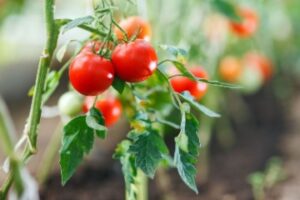
Here’s a quick guide to help you get started with your first hydroponic setup.
Selecting an area to set up your hydroponics farm: If you have a sunny balcony or access to a greenhouse, great! Some of us aren’t so lucky, though, so it’s a good thing you don’t always need sunlight. A spare room or even a basement will do fine as long as you have access to a power source to power LED grow lights.
Grow tomato plants from the seed: It’s best to start from scratch instead of trying to transplant them from a soil-based garden. Start growing your seeds in a nursery tray using a rock wool starter or planting medium like a square sponge. If using a rock wool, it should be soaked in water and the pH set to about 4.5 before setting the seeds.
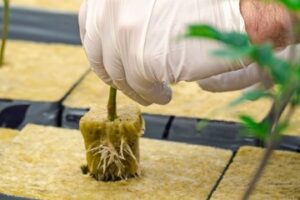
Place the seedlings under sunlight: As they start to sprout, place the seedlings under LED lights if possible. Leave them on for about 12 hours daily and avoid letting the roots get exposed to the lights to avoid damaging them.
Transplant the young seedlings: When these seedlings have grown big enough (about 4-5 leaves), and the roots begin to grow out from the bottom of the tray, it’s time to transplant them to the hydroponics system. Transfer the plant and the rock wool together and fill each pot with perlite (clay pebbles – we will discuss this later in this article).
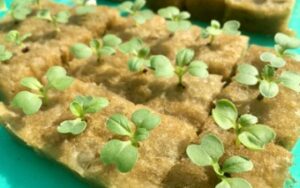
Nourishing the plants with water and nutrient solution: Hydroponic plant nutrients can be bought online or from nearby hardware stores like Home Depot, Lowe’s, or a local nursery. The nutrients are mixed with water as per the instructions, as the plants get their nourishment through this solution.
Selecting the hydroponics system: There are several types of automated hydroponics systems you can purchase or DIY. The easiest to set up is a top-down drip system. Place a reservoir of water and nutrients solution below the plants. Use a submersible water pump and set up irrigation lines to bring water from below and drip it into each pot. The nutrient solution should be allowed to drip through the perlite in the mesh pots and drain back into the reservoir chamber. Run this setup for the entire day (in some cases, about 18 hrs. are sufficient depending on the environment) and replace the solution every 6-8 days.
Expose the plants to about 14-16 hours of natural daylight daily: If the hydroponic system is indoors, set up LED grow lights and plug them into automatic timers so that the on/off cycle is automated to run about 16 hours daily. Leave the plants in complete darkness for 6-8 hours daily.
Monitor the pH level: Tomato plants require a pH of 5.5 and 6.2. To lower the pH, add phosphoric acid or add potassium hydroxide to raise it.
Regulate the temperature: Use fans or your home air conditioning to keep the temperature at 64F-74F in the daytime and 56F-64F at night.
Stake and prune the plants: Help your plants grow upright instead of sprawling out to the side by pruning them and attaching the stem to a stake.
Use a paintbrush to pollinate the blossoms: As soon as the stigma appears, use a soft paintbrush to grab pollen from one plant and transfer it to the stigma.

Leach the pots: Salt can build up around the roots of your plants. Leach them in clean water each week when you change the nutrient solution.
Monitor your growth: Harvest when ready and enjoy!
Even if you do not have a green thumb and know little about hydroponics, you will soon have fresh, juicy red tomatoes ready for picking. Outlined below are all the steps to grow Hydroponic Tomatoes using hydroponics. Firstly, choose a hydroponic system you’d want to use. Make sure to understand all the details, features, and how the system works. There are cheap kits available for large and even tiny spaces. Nutraponics has a selection of efficient systems designed by US-based architects and landscape designers with over 20 years of experience in sustainability-related designs.
A sound drip system, an Ebb & Flow setup, or an aeroponics system would be perfect. Still, even a deep-water culture (DWC) system or an NFT-based system will do. Nutraponics offers the first three systems mentioned.
Pick a Suitable Growing Medium
Hydroponics works better when the roots of the plants are firmly planted using a stable growing medium. It is an inert material that can hold on to the water, nutrients, and air over extended periods. Expanded clay pellets, rock wool, and perlite are some of the most commonly used examples of growing mediums. They are not expensive, they work well, and you can find them in most home stores or nurseries. You can also use coconut coir, a perfect fibrous system for hydroponics, or vermiculite to increase the absorption of liquids and air, respectively.
Choose Your Nutrient Mix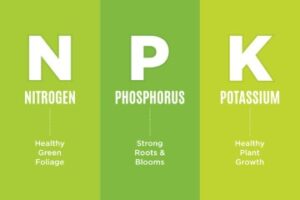 Hydroponics does not imply “growing plants in water”; it means “growing plants in a solution of nutrients and water.” Most plants cannot grow in pure water alone, even if some people grow them in tap or rainwater; there are traces of nutrients in it sufficient for the plant. But if you want tomatoes to grow well, strong, healthy, and have many fruits, you will need to use a suitable nutrient solution. Tomatoes, in particular, are plants that need to be well-nourished. An excellent hydroponic mix for tomatoes would be organic and have a low nitrogen level. The NPK (Nitrogen, Phosphorous, Potassium) ratio of the solution could be similar to 1:2:2 (10-20-20, 5-15-15, or 15-30-20).
Hydroponics does not imply “growing plants in water”; it means “growing plants in a solution of nutrients and water.” Most plants cannot grow in pure water alone, even if some people grow them in tap or rainwater; there are traces of nutrients in it sufficient for the plant. But if you want tomatoes to grow well, strong, healthy, and have many fruits, you will need to use a suitable nutrient solution. Tomatoes, in particular, are plants that need to be well-nourished. An excellent hydroponic mix for tomatoes would be organic and have a low nitrogen level. The NPK (Nitrogen, Phosphorous, Potassium) ratio of the solution could be similar to 1:2:2 (10-20-20, 5-15-15, or 15-30-20).
Select the LED Grow Lights for the System
If there is access to plenty of sunlight, there is no need to use LED grow lights. However, this is a step that is necessary if you plan to grow Hydroponic Tomatoes indoors, especially in a dark space without abundant sunlight. For example, suppose you want to turn an empty garage or a basement into a hydroponic farm. In that case, you will require to use some artificial lighting. Standard incandescent lights would not be as productive for tomatoes or plants grown using hydroponics. You will need lights that cover a wide range of the light spectrum, specifically the blue and red spectrum that plants need during their growth stages. The best lights are LED grow lights: They cover the full spectrum of plants’ needs, they do not heat the environment, consume very little electricity, and last for a longer time than most lights. LED grow lights can even have a timer attached, so you can set it and forget about them.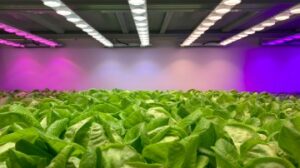
Tomatoes will need blue light in the early stages of growth when they are young and begin to grow leaves and red light once they blossom and produce fruits. Most LED grow lights are easily adjustable on the blue or red side of the spectrum. They have individual blue and red lights and warm white lights, and you can turn them on and off as required.
The Support Structure
Tomato plants need some support to grow, and this is why you may need a trellis or any support structure. Many hydroponic systems should have an integrated trellis or posts to support the tomato vines.
If you don’t have a system, you have a few options. Provide a frame or poles and sticks where you can support the tomato plants or leave the plants low, either by selecting a short variety or by pruning them regularly.
Getting The Right Seedlings
Many tomato plants are available, varying from sweet and tiny cherry tomatoes to large beefier ones. Selecting them is purely based on personal preference, and you can choose the ones that best suit your needs. The height of your tomato plants will be an essential factor to consider, especially if you plan to grow them in smaller rooms with limited space. Another consideration is the health of the tomato seedlings; you are looking for new seedlings with about 3- 5 small leaves. The seedlings should be at least 5″ tall or possibly a little taller. Ensure that they are green, healthy, and have a strong stem. Choose organic seedlings; if you want your plants to be fully organic, they should be so from birth.
The Nutrient Mix
Next, it is time to fill the reservoir of your kit with water and add the nutrient mix. A simple but essential step and you will only need a tiny dose, about a few drops per gallon. Do read the bottle or box instructions and follow as instructed. Ensure that the temperature of the nutrient mix is at room temperature before using it to nourish the plants.
Check the pH and EC Levels
The two critical parameters in hydroponics are the solution’s acidity and the solution’s electrical conductivity. The former tells you how alkaline or acidic the solution is. The second will tell you whether the solution has enough or less than the required nutrients. The pH meter and the EC meter can easily be bought online or from a local hardware store.
Setup the Hydroponics System
It’s time to set up your hydroponic farm! If it is an all-inclusive kit, all you will need to do is connect it to the mains. Most towers have instructions and manuals to help guide you through the process. Nutraponics Towers come with videos and a digital manual that help to install the towers easily.
Using the Growing Medium
You will need to properly wash and clean the growing medium before using it in the planting pots, and you will have to do this again every time you change plants. Water and mild alcohol will do. Once you have adequately cleaned the growing medium of your choice, you can put it in the mesh pots, ready to accept the healthy young seedlings.
Planting the Seedlings
Transplanting the tomato seedlings from the seeding bed into the growing medium with the mesh pots or net pots is similar to planting them in regular soil. Make sure to allow for enough clearance and space for the roots to grow and spread and cover around the base of the stem with the growing medium.
Installing and Setting the Timer
Unless you are using deep water culture, almost all other types of hydroponics will require setting the timer for the water cycles to ensure that the plants are timely and adequately nourished. Many grow systems will include the timer along with the setting instructions, but here are a few pointers:
The water cycles may depend on the weather and other circumstances; be ready to use some flexibility if the weather gets hot & dry or cold & wet. The cycles may not need to be the same during the day and at night, as fewer water cycles are required during the night, given the metabolism of the plants would be lower at night.
The water cycles change according to the hydroponic system you plan to use however:
You would run a cycle for an ebb and flow system for 10 – 15 minutes every 60-90 minutes during the daytime. If the environmental conditions are hot and dry, you may need 1 or 2 similar cycles to run at night. The water cycles can differ significantly with various hydroponic techniques. You can experiment by starting with 10 minutes cycles, then check how much of the growing medium is soaked in the nutrient solution after 50 minutes of the off-cycle, and adjust as needed to make sure the growing medium remains damp. You can limit the water cycles at night and avoid it if the plants thrive in an ideal environment. If not, you may consider running 1 or 2 cycles at night. With aeroponics, the cycles are about 3 to 5 sec every 5 minutes. The mist spray cycles are short bursts and frequent. As with other hydroponics technologies, there may be variations in aeroponics water cycles depending on the weather conditions and the plants.
Turning on The System
Finally, turn on the system – the water pump, the air pump, the timers, the LED lights, etc. In most systems, this is done simply by pushing a single button. Make sure to use the LED lamps as well! Now that the hydroponic garden is up and running, you can take a sit back (for a while). All that is required now is to maintain the system and plant care.
Hydroponic System Maintenance and Care
You will need to check your hydroponic system regularly, even if it’s a simple checking of the nutrient mix or making sure all the lights and timers are set up as they need to be. Check the pH and EC level often, preferably once every three days. If the EC level is higher than required, add water to the nutrient mix. If it is lower than needed, you may need to change the nutrient mix. Also, inspect the system for clogs and algae growth, preferably once every 8-10 days.
Keep Your Tomato Plants Short (If Necessary)
If you have no headroom for your tomato plants but have chosen a variety that grows tall, then do this: This should keep the plant low and promote the vines to increase sideways instead of higher.
Trim Off the Suckers
Tomato plants will most likely grow suckers, which are branches that come off the main stems. These look like small plants and grow as an “excessive branch” between the plant and its branches. Most people usually snip them off when the plant is young. The reason for doing this is because they drain the energy from the main branches, which provide for most of the fruits. Trimming these off allows the plant to grow tall and have a long main stem without lower branches, significantly increasing the yield. Use your hands, take the sucker at the base and snip it off with a swift and clean movement.
Tie Your Tomato Plants to The Frame Structure
Tomato plants will not grow straight up naturally and require to be tied to a supporting frame, trellis, stick, or pole. You can use a wire, a rope, or even a plastic strip, to secure the plant to the structure. Remember to always tie the main stem of the plant to the support. Avoid connecting the branches. Also, avoid tying it tight; leave some room for the stem to grow and even flex a little. Ensure you secure them before they begin to blossom, as soon as or even before they bear fruit. Keep tying your plant as it grows.
Check For Diseases or Pests
Hydroponic plants are healthier than those grown traditionally, and they rarely are infested by pests or get infected with diseases. Nevertheless, check that your plants are healthy, that they have the dark and deep color that tomato leaves and stems are famous for, and that there are no severe lacerations and pests. If there are any issues, there are always organic solutions for most diseases or infestations- they can be cured using simple solutions with neem oil, garlic, or even essential oils. Generally, all such issues with hydroponic plants are, in fact, relatively easy to solve and rarely too threatful. Avoid spraying chemicals or pesticides on hydroponic plants, or they will end up right into the nutrient mix…which is what indirectly feeds you, not just the tomatoes.
Finally, Reap the Tomatoes
You should have the first set of ripe Hydroponic Tomatoes within about four to five weeks since planting the seedlings. A lot depends on the environment, assortment, and light and nutrient mix, but be sure that you will be harvesting within two months!

A beginner’s guide to growing tomatoes using hydroponics using LED grow lights.
What is the ideal temperature that tomatoes hydroponically grown tomatoes thrive in?
Daytime 76°F – 80°F
Night 68°F – 72°F
What is the ideal humidity to grow tomatoes using hydroponics?
The best humidity to grow tomatoes is about 50-60%.
How long should the LED grow lights stay on during the “daytime” in a hydroponic setup?
Vegetative phase (initial growing stage) of a hydroponic tomato plant: About 18 hrs./day (first 4-5 weeks)
Flowering phase (budding) of hydroponic tomato plants: About 12 hrs./day (next 8-10 weeks)
What is the ideal distance between the LED grow lights and the tomatoes?
The space between the two should be approx. 16″ for 400W grow lights, 16 – 24″ for 600W grow lights and 24″ for 1000W grow lights.
What are the typical ventilation requirements for a hydroponic setup?
Ventilation should be enough to maintain the right temperature and humidity of around 50%. The tomato plant leaves should have a slight flutter and free-flowing air during the day. It is preferred to have excessive airflow rather than little or no ventilation to increase CO2 levels for the tomato plants.
Is any particular brand of hydroponic nutrients recommended by Nutraponics?
All hydroponic nutrients will grow hydroponic tomatoes. The best nutrients will have an NPK ratio of 1:2:2
What Electrical Conductivity should one target with hydroponic tomatoes?
EC is a value used to measure the salts in the water. Hydroponic tomatoes’ EC (Electrical Conductivity) varies with the growth phase and based on the growing medium used. It also varies for each brand of hydroponic nutrients. A general guide to hydroponic EC (it gets lower as the plant’s growth stages progress):
Vegetative Stage: 1.1 – 2.0 EC
Flowering Stage: 1.8 – 2.3 EC
Before Harvest: 0 – 0.4 EC
Note: To measure your EC, you will need an EC/TDS pen which can easily be bought online.
What is the ideal pH one should maintain for hydroponic tomatoes?
The broad wide range is 5.2 – 6.8. Above or below, this will lead to the plant not absorbing some of the minerals from the hydroponic nutrient solution. An ideal level of pH for plant absorption is between 5.6 and 5.8. This is when all the minerals are absorbed to full capacity encouraging proper plant growth. In the last three weeks of flowering, use a pH level of 6.2 to 6.8. This range allows for more P/K minerals to be available to the plants.
Is aerating the hydroponic nutrient solution necessary?
Aerating nutrients is a good idea. It improves hydroponic tomato plant health by adding Oxygen to the system and protecting against stagnant water.
What is the ideal temperature for a hydroponic nutrient solution?
Hydroponic nutrients should be between 66°C and 72°C. Should the solution be too cold, use a water heater to raise the water temperature.
How often should I flush the nutrient mix off the hydroponic system?
Approximately every 7-10 days is recommended. A tiny amount of hydroponic nutrients in flush solution (EC 0.6) will save the tomato plant from unnecessary stress. Make sure the temperature and pH of the flush water are correct. Avoid over flushing as this can cause a rather drastic change in the PPM/EC/pH levels. A general guide is about half the volume of water to the amount of media in the pot.
Avoiding the leaf tips of hydroponically grown tomatoes from burning.
Burnt tomato plant tips can be due to too much fertilizer (excessively high EC), too much salt in the nutrient mix, insufficient water, LED grow lights too close to the leaves, or not regular flushing of the mix. Certain hydroponic nutritional deficiencies can also cause leaf tips to burn.
What can cause hydroponic tomato leaves to turn yellow?
Yellow leaves on hydroponically grown tomatoes can be caused due to several issues:
The hydroponic nutrient mix is too warm (66-74F is ideal)
Low levels of Oxygen in hydroponic nutrients due to lack of aeration
Overwatering
The onset of root disease
The pH is too high
Too much salt in the water
The surrounding temperature is not ideal
These can deprive the plant of nutrients in the correct quantities and balance.
One of the main tasks when caring for the tomato plants once they’re growing is regularly checking up on them to ensure they’re healthy and that everything’s working correctly.
Replace the Nutrient Solution
It is vital to change the solution in your reservoir approximately once a week, depending on your feeding schedule.
Check pH Level regularly
Regularly checking the acidic level of the nutrient solution is essential. This ensures that the tomato plants can effectively absorb all vital nutrients. The preferred pH level, as mentioned earlier, is ideally between 5.2 and 6.8. However, tomatoes thrive best when the pH is around 5.6 and 5.8, so you’ll need to check and maintain it regularly. Vinegar and citric acid will help lower the pH level, while baking soda will help increase it. It is recommended to use special pH lower and pH higher solutions, which offer longer-term fixes.
Pruning the Tomato Plants
Once the tomato plants start growing more extensively, you’ll need to begin training and pruning the vines to stay short the yields are effective. These will produce tomatoes for many seasons. You want to keep the tomato plant’s energy on growing tomatoes, not more branches and leaves.
-Tilden Cooper
Grow 100 planting sites, monitor ph levels, water temperature, water levels, and control light and water cycles.
© Copyright 2024 Nutraponics. All Rights Reserved.